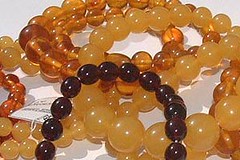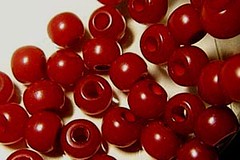Amber is fossilized resin which has succinic acid present in its chemical makeup. It begins as resin tree sap drippings and progresses into copal then amber as it fossilises, which can take millions of years. To transform from resin to copal and then to amber relies on polymerisation and terpene evaporation.
There are three commonly known amber types that are available today - Baltic amber, Dominican amber and “young amber”.
Baltic amber is one of the best known authentic ambers. It was deposited as sap oozing from now-extinct resinous trees as much as 50 million years ago and laid down in deposits through what is now the coast of the Baltic Sea as well as parts of Russia. The Kaliningrad Amber Factory in Russia produces 90% of the world’s amber.
Dominican amber was deposited approximately 10 to 25 million years ago in what are now the Dominican amber.
More recent, but still valuable is the “young amber” deposited by deciduous trees in what is now Poland from 10000 to 1 million years ago. The reason from this type of amber is not properly amber and should more correctly be called copal (pictured below right). A similar substance, Kauri Gum, can be found in New Zealand.
Tibetan amber is NOT real amber. In my experience this is a cheap plastic substitute that is commonly found on e-bay. Also be aware that some glass beads are called “amber” due to their colour alone, however I have had success through e-bay when searching on “Baltic amber” (pictured below left) and observing the appearance of the beads; especially look for the swirls that are formed by slow gradual oozing prior to fossilisation.
Baltic amber can have succinic acid present between the ranges of 3 to 8 percent. Amber which is clear usually has lower levels of succinic acid and increases as the amber becomes more opaque.
One of the best tests on real amber is the hot point test. It involves heating up a piece of wire or similar equipment and poking it into an inconspicuous place on the item being tested. Amber should give off a pine gum or resinous smell and the slight puncture mark may appear white.
Historically, amber beads were made by taking a block of amber, cutting it roughly to shape and drilling a hole through. Its final shape was attained by turning it on a bow lathe before polishing. The Vikings produced many different amber articles, including wedge shaped beads and amulets, sometimes even playing pieces for games.
In Viking mythology amber was formed from Freya’s tears. She was married to Odur the god of sunshine, but when he left her to roam in distant lands she followed him weeping. Her teardrops changed to gold in the rocks and amber in the sea.
Amber is said to clean and purify the system of the wearer. The aura of this stone is believed to act on endocrine and digestive systems. Its magnetic properties (rubbed against wool, amber attracts paper) is believed to be beneficial against fatigue and depression. Amber brings joy to life and gives the courage necessary to overcome anxiety. Stone of the sun, amber warms the heart in literal and figurative sense and is believed to be a good remedy for colds and flu.
Additional Resources
Amber Gallery - Fakes and Amber Tests
Viking Answer Lady - Amber
Regia Anglorum - Glass and Amber
Subscribe to:
Post Comments (Atom)




No comments:
Post a Comment